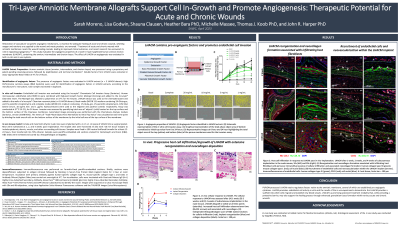Laboratory Research
(LR-035) Tri-Layer Amniotic Membrane Allografts Support Cell In-Growth and Promote Angiogenesis: Therapeutic Potential for Acute and Chronic Wounds
Friday, April 28, 2023
7:15 PM - 8:30 PM East Coast USA Time

Lisa Godwin, .; Shauna Campbell, BS; Heather Bara, PhD; Michelle Massee, MS; Thomas Koob, PhD; John Harper, PhD
Introduction: Restoration of vasculature via specific angiogenic mechanisms, is essential for adequate healing of acute and chronic wounds, whereby, oxygen and nutrients are supplied to the wound and waste products are removed.1 Treatment of acute and chronic wounds with amniotic membranes resets the wound healing cascade leading to improved clinical outcomes, and recent research has uncovered its role in regulating angiogenesis.2-5 This study evaluates the angiogenic properties of a novel tri-layer lyophilized human amnion chorion membrane (LHACM*), containing the amnion, intermediate and chorion layers. The effect of LHACM on angiogenesis was evaluated in both in vitro and in vivo systems.
Methods: LHACM was prepared using the PURION process, consisting of gentle cleansing, followed by lyophilization and terminal sterilization. Multiplex ELISA was used to quantify angiogenic factors within an extract of LHACM. The effect of LHACM on invasion was modeled using an in vitro transmembrane cell invasion assay with human microvascular endothelial cells (HMEC1). The in vivo response was evaluated in a subcutaneous implantation of LHACM in athymic nude mice, followed by histological and immunofluorescent assessment of the implant sites at 1, 2, and 4 weeks post-implantation.
Results: Pro-angiogenic factors were detected and quantified in extracts of LHACM using a multiplex ELISA. LHACM stimulated angiogenic activity both in vitro and in vivo. LHACM extract induced invasion of HMEC1 cells in an in vitro transmembrane cell invasion assay. Following subcutaneous implantation of LHACM in nude mice, early infiltration of host cells within the implant was evident, and as time elapsed matrix remodeling was apparent and associated with the presence of endothelial cells, migrating fibroblasts and new collagen deposition.
Discussion: PURION-processed LHACM retains regulatory factors native to the amniotic membrane, several of which are established pro-angiogenic cytokines. These factors promote endothelial cell activity in vitro and the results of the in vivo experiments demonstrate that LHACM provide a scaffold into which cells migrate and establish new blood vessels. LHACM is a promising wound dressing that, while providing a protective barrier, may also support the healing process through enhanced granulation tissue formation within various acute and chronic wounds.
Methods: LHACM was prepared using the PURION process, consisting of gentle cleansing, followed by lyophilization and terminal sterilization. Multiplex ELISA was used to quantify angiogenic factors within an extract of LHACM. The effect of LHACM on invasion was modeled using an in vitro transmembrane cell invasion assay with human microvascular endothelial cells (HMEC1). The in vivo response was evaluated in a subcutaneous implantation of LHACM in athymic nude mice, followed by histological and immunofluorescent assessment of the implant sites at 1, 2, and 4 weeks post-implantation.
Results: Pro-angiogenic factors were detected and quantified in extracts of LHACM using a multiplex ELISA. LHACM stimulated angiogenic activity both in vitro and in vivo. LHACM extract induced invasion of HMEC1 cells in an in vitro transmembrane cell invasion assay. Following subcutaneous implantation of LHACM in nude mice, early infiltration of host cells within the implant was evident, and as time elapsed matrix remodeling was apparent and associated with the presence of endothelial cells, migrating fibroblasts and new collagen deposition.
Discussion: PURION-processed LHACM retains regulatory factors native to the amniotic membrane, several of which are established pro-angiogenic cytokines. These factors promote endothelial cell activity in vitro and the results of the in vivo experiments demonstrate that LHACM provide a scaffold into which cells migrate and establish new blood vessels. LHACM is a promising wound dressing that, while providing a protective barrier, may also support the healing process through enhanced granulation tissue formation within various acute and chronic wounds.

.png)